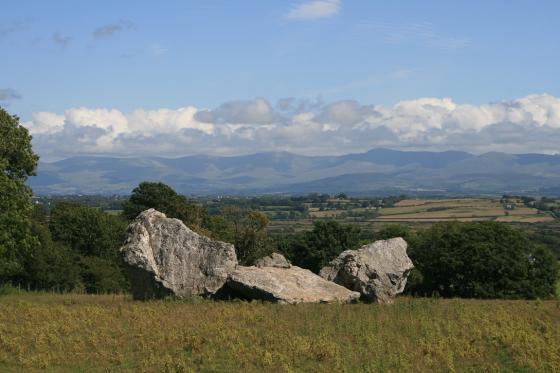



Looking out across the great pit is like a scene from a sci fi film

These mines have been worked since the early Bronze age and many repeated attempts to extract copper right up to the present day

Amazing colours from the copper and other minerals contained within the rock and soil

Looking out towards Snowdonia

From ‘Cambria Depicta’ by Edward Pugh (1816).

From ‘Cambria Depicta’ (1816) by Edward Pugh.



From the new heritage trail viewing platform.
From an article published on the BBC News web site on 21st May 2005:
Mining for copper and zinc could return to Anglesey’s Parys Mountain mine after an absence of almost 100 years.
As a result of recent increases in world metal prices, owners Anglesey Mining plc are starting exploratory drilling work.Finance director Ian Cuthbertson said they were confident of “significant reserves” at the site, which has been mined since the Bronze Age.
When I was there I met a very helpful bloke who was the part time warden, and he showed me a rock he was carrying in his bag, hand sized but heavy – from Porth wen (near bull bay) it had been fashioned into a hand tool. Because of this I asked him, wasn’t the area mined in the copper age and long before the Romans, but he wasn’t keen to agree with this. Yet he was showing me the evidence of pre-history mining in that area.
It’s a great place to visit just after the rain as the colours are amazing.
This is from ‘A Voyage round Great Britain, undertaken in the Summer of the Year 1813’, by Richard Ayton, and illustrated by William Daniell. I know it dates from a few millennia after the mining in the Bronze Age, but it was an industrial site then too. The following does make you wonder what the mountain looked like in the Bronze Age, the miners’ lives, what people who lived there and visitors might have thought of it, where and how they did the smelting and so on.
On every part of its surface the hill is as bare as the public road. No kind of vegetation can live in this sulphureous atmosphere; not a weed, not a lichen on the rocks has been spared.. We were amazingly struck with the first view of the mine, which is truly an astonishing monument of of human industry.. The mine has been worked like a stone quarry, and an immense crater has been formed nearly a mile in circumference; and in many parts, three hundred feet in depth. As we stood upon the verge of this tremendous chasm, it appeared to us like a mighty work of nature, produced by some great convulsion, but, certainly, suggested to our minds nothing so mean as the pick-axe and the spade. There were but few people at work, and their figures, disovered here and there among the huge rocks, looked merely as flies upon a wall, and one could scarcely imagine that, by these little creatures, each picking its little hole, the mountain had been thus demolished. The sides of the mine are mostly perpendicular, but the bottom is broken and irregular, and penetrated in various parts, by wide and deep hollows, in which veins of peculiar richness have been followed...
Vast amounts of information about the mines (some of which relates to the prehistoric).
‘EXTREME Archaeology’ at Parys Mountain – a television programme with the ubiquitous Alice Roberts. Includes reports, photos, and various ‘video fly throughs’. Focuses on exploration of the prehistoric parts of the mines.













































